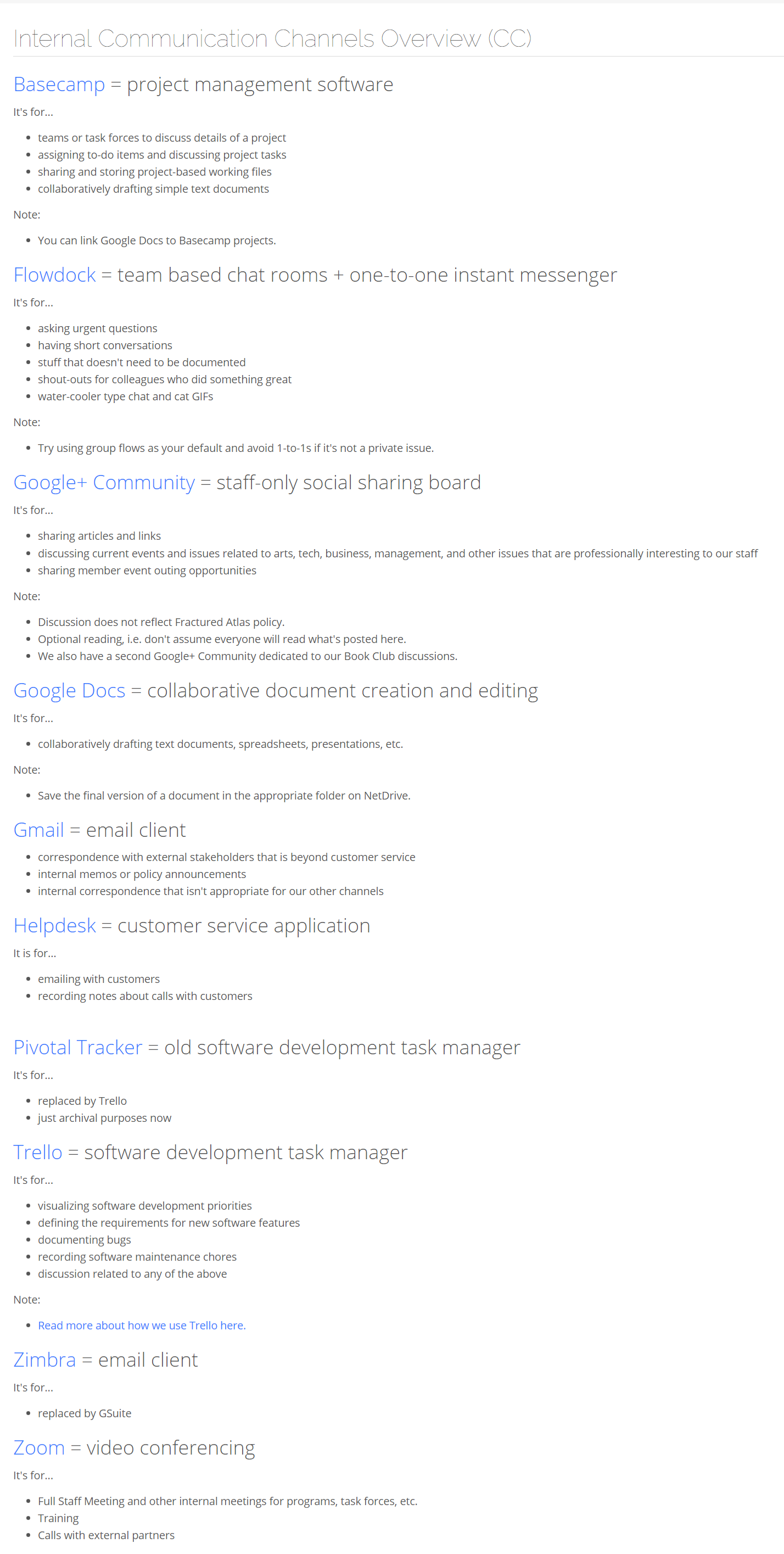There’s a channel for that
Big Ideas | How We Work | Communication | People Operations | Human Resources
Communicating over space and time

[Editor's Note 3/17/10: While the information below is still useful — particularly how channels are used — we also published this related and updated piece.]
“Communication is key” is one of those business-isms, like “Culture eats strategy for breakfast,” that seem to appear in most of the articles I read about organizational culture. It’s not misplaced. Open, honest, and respectful communication is a key ingredient in high performing teams and organizations.
At Fractured Atlas, about 25% of our staff work in ten different states, 50% more work at least one day a week remote, and the remaining 25% of us work five days a week out of our midtown Manhattan headquarters (that is, unless we happen to be traveling.) We never all work in the same physical location except for four days a year during our annual Oktechberfest. When I mention this to people, one of the first questions they typically ask is, “How do you communicate with each other if you’re all not in the same physical space?” Short answer: It depends.
We use Gmail for Business and a Skype-like phone system, but that’s just the beginning. We use Flowdock, and Zoom, and Basecamp, and Trello. Google Docs, our Helpdesk, and an Internal Knowledge Base (IKB). A knowledge base that includes an article about how to use these various communication channels:

Fractured Atlas communication channels circa 2017
Email exchanges or phone calls aren’t always the most efficient or effective means of communicating. “Who wants to grab Chipotle for lunch?” doesn’t need to be an all staff, reply all email thread. Perhaps a quick exchange on Flowdock, complete with burrito emoji, is a more appropriate channel to coordinate the effort.
Another hallmark of high performing organizations is increased transparency around information. Transparency allows us to make better, more informed decisions with broader context for how our decisions fit into — and impact — the larger organizational picture. Tools like Basecamp, Flowdock, and Trello allow organizations to more openly share information. For most people it’s an FYI — we’re making this change — but for others, it’s an important heads up that the change will impact their workflow and have cascading effects.
As you can see from our guide, there’s a purpose to each channel and, in many cases, these channels offer transparency that’s hard replicate with email, except by using the universally disdained company-wide reply all. Do you just want to ask who left the tasty banana bread in the kitchen? Flowdock. Detailing, ranking, and scheduling a series of software development features? Trello. Organizing meeting agendas and team priorities? Basecamp. You get the picture.
Word of caution and/or context
At Fractured Atlas, we didn’t start using ten communication channels one day. That would have been disruptive and confusing and ultimately unhelpful. Communication channels were added as experiments and evolve over time.
Many of our communications tools were first tested by our software engineers since no two even live in the same state. (They are, by definition, an entirely virtual team.) After they vet one, we start to adopt it throughout the organization. Maybe the external relations team test one first while a sampling of people from the Programs and People teams test another option. From there, we add a few more people and suddenly — voilà — everyone in the organization is using it and can’t remember the days before Flowdock.
#ProTip
Software applications that cost money often offer trial periods or pared down versions for a limited number of users. Experiment with a small group of people to see if it’s worth the investment. Then, if you’re sold on it, email the company to ask if they offer a discount for nonprofit organizations (if you are, in fact, a nonprofit organization). Most offer at least 10–20% off their regular price.
Hope you find the above guide helpful. Ping me if you have any questions.
About Tim Cynova
Tim wears a multitude of hats, all in service of creating anti-racist workplaces where people can thrive. He currently is co-CEO of Fractured Atlas (an entirely virtual organization with staff spread across multiple states and countries) and a Principal of the consulting group Work. Shouldn't. Suck. He serves on the faculty of Banff Centre for Arts & Creativity and The New School teaching courses in People-Centric Organizational Design; he's a trained mediator, and a certified Senior Professional in Human Resources (SPHR). Earlier in his career, Tim was the Executive Director of The Parsons Dance Company and of High 5 Tickets to the Arts in New York City, had a memorable stint with the Cincinnati Symphony Orchestra, was a one-time classical trombonist, musicologist, and for five years in his youth he delivered newspapers for the Evansville, Indiana Courier-Press. Also, during a particularly slow summer, he bicycled 3,902 miles across the United States.


